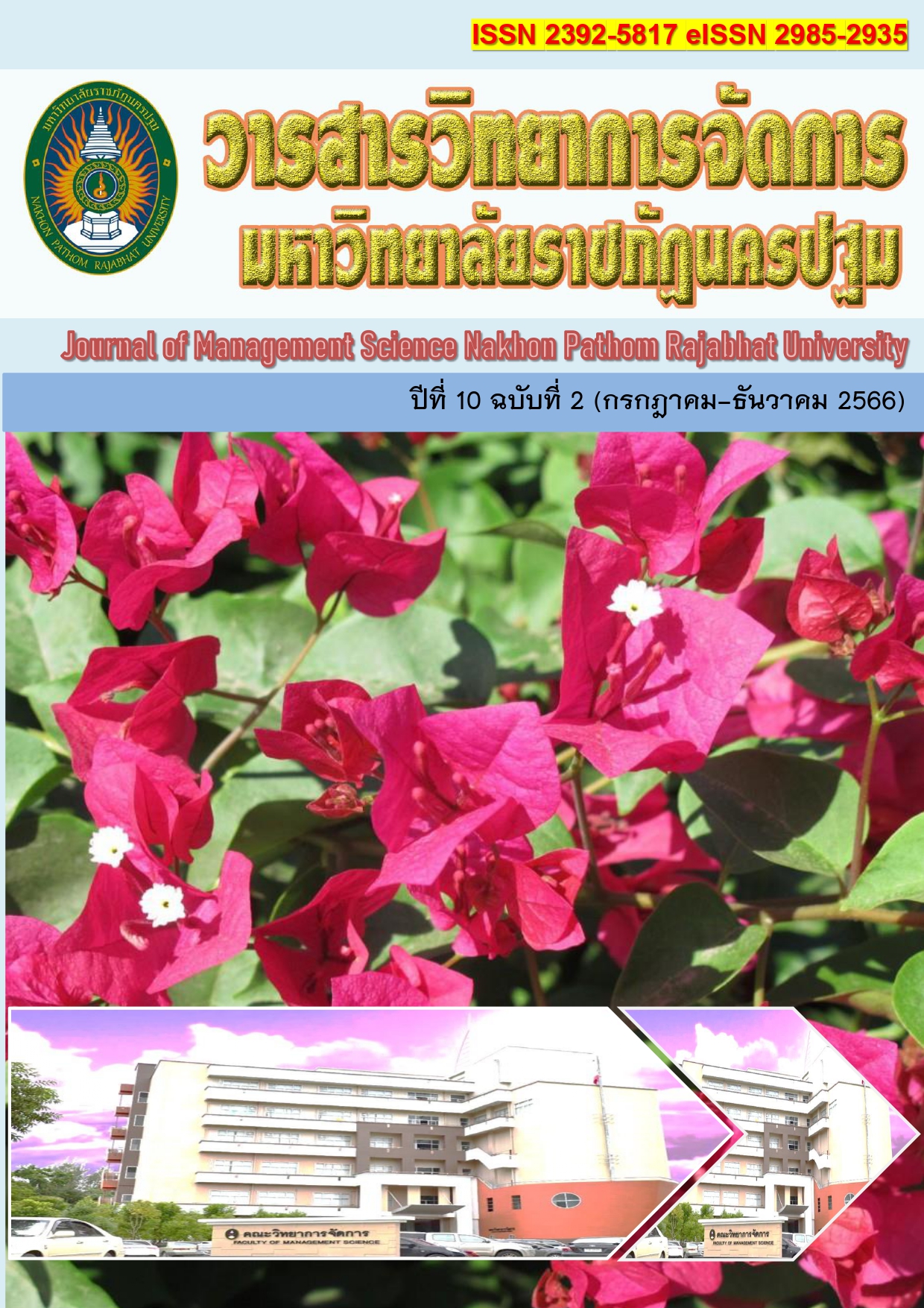Adaptation to Work from Home under Situation Covid-19 Crisis: A Case Study Personnel of Sena District Office Ayutthaya Province
Main Article Content
Abstract
The findings showed that (1) the problem of work from home under the Covid-19 crisis is that personnel of the Sena District Office has never worked from home before there was a crisis of COVID-19. There is no preparation and a lack of knowledge and understanding. (2) The environment in support of work from home under the COVID-19 crisis found that The state policy does not have measures for officers who work from home that are good enough to make the work out as inefficient as it should be. Many Outsource workers of government organizations so taking turns going into the office to work. And personnel who looking want the organization to have support for equipment and facilities to be up to trend so that organizations at all levels can develop for work as well. (3) Guidelines for adaptation to Work from Home under Situation Covid-19 Crisis The government should have a concrete Work from Home policy that is appropriate for the situation and the health system should focus on balancing the health of workers between work at home and their private lives.
Article history: Received 4 April 2023
Revised 11 August 2023
Accepted 14 August 2023
SIMILARITY INDEX = 1.58 %
Article Details

This work is licensed under a Creative Commons Attribution-NonCommercial-NoDerivatives 4.0 International License.
The views and opinions of the article appearing in this journal are those of the author. It is not considered a view and responsibility of the editorial staff.
References
กัญญาภัทร ปานหอมยา และสุวรรณี แสงมหาชัย. (2566). การทำงานทางไกลในสถานการณ์ COVID – 19 ขององค์การภาครัฐไทย. วารสารวิทยาการจัดการ มหาวิทยาลัยราชภัฎนครปฐม, 10(1), 123-134.
จิราภรณ์ ชนัญชนะ อำนวย บุญรัตนไมตรี ฐิติมา โห้ลำยอง และศุภวัฒน์ สุขะปรเมษฐ. (2566). ดัชนีชี้วัดการเป็นองค์กรนวัตกรรมในประเทศไทย. วารสารวิทยาการจัดการ มหาวิทยาลัยราชภัฎนครปฐม, 10 (1), 160-170.
ชุลีพร ชอบสุข บุศย์รินทร์ อารยะธนิตกุล สุอารี ล้ำตระกูล วชิรา ตันเสนีย์ ผ่องแผ้ว พุ่มศรีนิล และปาริชาติ ยิ่งประเสริฐ. (2561). การพัฒนาแบบบันทึกทางการพยาบาล หอผู้ป่วยเด็กอาการหนัก โรงพยาบาลพระมงกุฎเกล้า. วารสารพยาบาลทหารบก, 19(2), 231-240.
ประกาศ ก.บ.ศป. เรื่อง ยกเลิกประกาศ ก.บ.ศป. เรื่อง มาตรการป้องกันการแพร่ระบาดของโรคติดเชื้อไวรัสโคโรนา ๒๐๑๙ (Coronavirus Diseases 2019 : COVID- 19). (2565, 14 พฤษภาคม).
ราชกิจจานุเบกษา. เล่ม 139 ตอนที่ 71: 16-17.
ปาริฉัตร โชติภูมิเวทย์. (2564). การบริหารจัดการกระบวนการทำงานที่บ้าน (WFH) เพื่อคุณภาพชีวิตของพนักงานต่อประสิทธิภาพการทำงานในภาวะวิกฤตโควิด-19 ของกลุ่มธนาคาร. การค้นคว้าอิสระการจัดการมหาบัณฑิต มหาวิทยาลัยมหิดล.
ปิยพร ประสมทรัพย์ พิเชษฐ์ เชื้อมั่น และโชติ บดีรัฐ. (2564). Work from Home (WFH): “ทำงานที่บ้าน” อย่างไรให้เวิร์คและมีความสุข. Journal of Roi Kaensarn Academi, 6(10), 371-381.
พรรัตน์ แสดงหาญ. (2563). การปรับตัวในการทำงานที่บ้านของผู้ปฏิบัติงานในเขตพัฒนาพิเศษภาคตะวันออกในช่วงวิกฤตโควิด-19. วารสารการจัดการธุรกิจ มหาวิทยาลัยบูรพา, 9(2), 14-33.
พิชญนันท์ สอนวิสัย และสุรวี ศุนาลัย. (2565). การปรับตัวในการทำงานและผลการปฏิบัติงานช่วงโควิด-19 กรณีศึกษาพนักงานธนาคารเอกชนแห่งหนึ่ง ในกรุงเทพมหานคร. วารสารวิทยาการจัดการ มหาวิทยาลัยราชภัฎนครปฐม, 9(2), 148-157.
ศศิวิมล คำเมือง, และกัมปนาท วงษ์วัฒนพงษ์. (2565). ทิศทางการปรับตัวขององค์กรและทรัพยากรมนุษย์สู่วิถีการทำงาน ในรูปแบบวิถีปกติใหม่. Journal of Modern Learning Development, 7(8), 354-367.
ศุภานน ตามะ, และปัทมาวรรณ จินดารักษ์. (2566). การปรับตัวของพนักงานในการปฏิบัติงานที่บ้านที่ส่งผลต่อประสิทธิภาพการทำงานของพนักงาน กรณีศึกษา บริษัท เฮงลิสซิ่ง แอนด์ แคปปิตอล จำกัด (มหาชน) สำนักงานใหญ่. วารสารบริหารธุรกิจและศิลปศาสตร์ ราชมงคลล้านนา, 11(1), 85-100.
สำนักวิเคราะห์และประเมินผล.(2566). ความหนาแน่นประชากรระดับจังหวัด จำแนกรายอำเภอ ตั้งแต่ พ.ศ. 2540 - พ.ศ. 2564. [ออนไลน์]. ค้นเมื่อ 19 กรฏาคม 2565 จาก https://office.dpt.go.th/stbd/th/statistic-population-powerbi.
เสาวรัฐ รัตนคําฟู, และเมธ รัชตวิจีน. (2563). ผลกระทบของการทํางานที่บ้าน (Work from Home) ในช่วงโควิด - 19 : กรณีศึกษาของทีดีอาร์ไอ. [ออนไลน์] สืบค้นเมื่อ 1 เมษายน 2566, จาก: https://tdri.or.th/2020/05/impact-of-working-from-home-covid-19/.
อนพัทย์ พัฒนวงศ์วรัณ. (2566). กลยุทธ์การปรับตัวเพื่อความอยู่รอดของผู้ประกอบธุรกิจสตาร์ทอัพ ในยุคการพลิกผันทางดิจิทัล. วารสารวิชาการสังคมศาสตร์เครือข่ายวิจัยประชาชื่น, 5(1), 60-75.
ภานุวัฒน์ ศรีมาฆะ, และอุมาพร มุณีแนม. (2564). การปรับตัวของผู้ประกอบการค่ายมวยไทยท่ามกลางสถานการณ์ การระบาดของโควิด-19 จังหวัดภูเก็ต. วารสารวิชาการการท่องเที่ยวไทยนานาชาติ, 17(1), 164-181.
Arkoff, A. (1968). Adjustment and Mental Health. New York: McGraw-Hill.
Bernard, Harold W. (1960). Health for Classroom. New York: McGraw-Hill.
Coleman, James C. (1950). Abnormal Psychology and Modern Life. New York: Scott, Foresman and Company.
Demerouti, E., Derks, D., ten Brummelhuis, L.L., Bakker, A.B. (2014). New Ways of Working: Impact on Working Conditions, Work–Family Balance, and Well-Being. In: Korunka, C., Hoonakker, P. (eds) The Impact of ICT on Quality of Working Life. Springer: Dordrecht.
Fonner, K. L., and Roloff, M. E. (2012). Testing the Connectivity Paradox: Linking Teleworkers' Communication Media Use to Social Presence, Stress from Interruptions, and Organizational Identification. Communication Monographs, 79(2), 205-231.
Galanti, T., Guidetti, G., Mazzei, E., Zappalà, S., and Toscano, F. (2021). Work from Home During the COVID-19 Outbreak: The Impact on Employees' Remote Work Productivity, Engagement, and Stress. Journal of occupational and environmental medicine, 63(7), 426–432.
Hill, E. J., Erickson, J. J., Holmes, E. K., and Ferris, M. (2010). Workplace flexibility, work hours, and work-life conflict: finding an extra day or two. Journal of family psychology: JFP: journal of the Division of Family Psychology of the American Psychological Association (Division 43), 24(3), 349–358.
Irawanto, D., Novianti, K., and Roz, K. (2021). Work from Home: Measuring Satisfaction between Work–Life Balance and Work Stress during the COVID-19 Pandemic in Indonesia. Economies, 9(3), 96.
Roy, Sr. C., and Andrews, H. (1999). The Roy adaptation model (2nd ed.). Stamford: Appleton and Lange.
Van Zoonen, W., Sivunen, A., Blomqvist, K., Olsson, T., Ropponen, A., Henttonen, K., and Vartiainen, M. (2021). Factors Influencing Adjustment to Remote Work: Employees’ Initial Responses to the COVID-19 Pandemic. International Journal of Environmental Research and Public Health, 18(13), 6966. http://dx.doi.org/10.3390/ijerph18136966.


